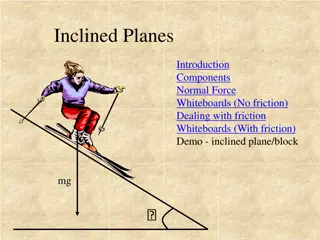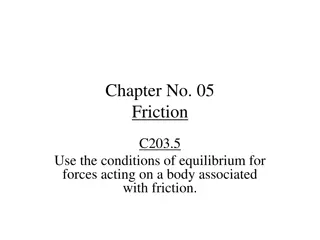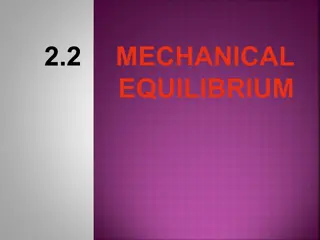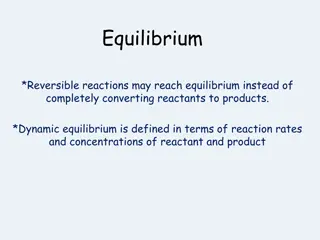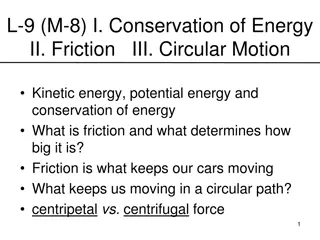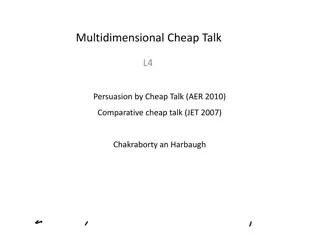Friction and Equilibrium in Physics
Concepts of friction and equilibrium in physics, including definitions of forces like weight, tension, and reaction force. Learn about the relationship between friction force and reaction force, solving equilibrium problems, and the significance of limiting equilibrium. Find practical examples and calculations to understand the direct relationship between friction and reaction forces, as well as measuring the coefficient of friction on different surfaces."
Download Presentation

Please find below an Image/Link to download the presentation.
The content on the website is provided AS IS for your information and personal use only. It may not be sold, licensed, or shared on other websites without obtaining consent from the author.If you encounter any issues during the download, it is possible that the publisher has removed the file from their server.
You are allowed to download the files provided on this website for personal or commercial use, subject to the condition that they are used lawfully. All files are the property of their respective owners.
The content on the website is provided AS IS for your information and personal use only. It may not be sold, licensed, or shared on other websites without obtaining consent from the author.
E N D
Presentation Transcript
Friction Equilibrium
Friction: Equilibrium KUS objectives BAT Understand the directly proportional relationship between Friction force and Reaction force BAT Solve equilibrium problems using coefficient of friction Starter: Write a definition for each of these forces Weight Tension Reaction (or Normal contact force)
What is Friction? The resistance that one surface or object encounters when moving over another . Friction is best given by Fr or Frmax Do not confuse Fr with F for Resultant Force
Limiting Equilibrium: This is when the magnitude of the frictional force is just sufficient to prevent relative motion Friction is a Force on objects caused by a touching surfaces resistance to a direction . Rougher surfaces cause greater friction The coefficient of friction is a measure of this roughness of different surfaces. There is a direct relationship between friction and the reaction force when an object is touching a surface ???????? ?? when a particle is in equilibrium and static ???????? = ?? when a particle is moving Remember: An object moving at a constant velocity will still be in equilibrium An accelerating object is subject to F=ma
WB 1 max friction: Finding coefficient friction A Trolley of mass 50 kg is being dragged along the ground at a constant velocity by a force of 150 N at an angle of elevation of 25 . Find the coefficient of friction between the ground and the trolley a) What is the normal Reaction force? b) What is the Friction force? ?) ? = 50? 150sin25 = 426.6 ? 150 cos 25 150 sin 25 150 R Fr 250 ?) ?? = 150cos25 ?? = 135.9 ? W = 50 9.8 = 490 ?? = ? =?? ?=135.9 426.6= 0.319
WB 2 max friction: Finding the coefficient of friction A Trolley of mass 50 kg is being dragged along the ground at a constant velocity by a force of 150 N at an angle of elevation of 250 a) What is the Reaction Force? b) What is the Friction force? c) Find the coefficient of friction if friction is at its maximum ?) ? = 50? 150sin25 = 426.6 ? 150 cos 25 150 sin 25 150 R ?) ?? = 150cos25 = 135.9 ? Fr 250 ?) ?? = ? =Fr R=135.9 W = 50 9.8 = 490 426.6= 0.319
Measuring the coefficient of Friction Aim: To find values for the coefficient of friction of different surfaces Board calculator Equipment: 1 kg weight Carpet, smooth board, sandpaper, Big protractor OUTLINE METHOD: Place the 1 kg weight on the board Raise the board to the point where the weight is about to move (point of slipping) Measure the angle of the slope using the Protractor Repeat with different surfaces Find the coefficient of friction for each surface Comment on the validity of your results
WB3. Object on a slope about to go up the slope A Block with mass 3 kg is pushed by a force parallel to the direction of the slope .The block is at a tipping point where it is about to go up the slope. The slope surface has coefficient of friction of 0.3 and is at 280 to the horizontal. Find the values of friction and the Push force 280 Weight
WB3 Object on a slope about to go up the slope solution i) R = 29.4cos 28 = 25.96 ii) Friction = R = 0.3 x 25.96 = 7.79 N 280 29.4 sin 28 29.4 cos 28 280 iii) Push =friction + component of weight downslope Push = 7.79 + 29.4 sin 28 = 21.59 N
WB4 Object on a slope about to go down the slope A Block with mass 8 kg is at the point of slipping down a rough slope. The slope is at 280 to the horizontal. Find the value of the coefficient of friction of the slope Friction will be up the slope 280 Weight
WB4 Object on a slope about to go down the slope solution i) R = 78.4cos 28 = 69.2 ii) Equilibrium Friction= 78.4 sin 28 = 36.8 N 78.4 sin 28 78.4 cos 28 280 280 iii) Friction = R =36.8 69.2= 0.532 Weight = 8 x 9.8=78.4
WB5. Simultaneous equations question A Block with mass 3 kg is held at rest on a rough slope by a horizontal force (Push). The slope has coefficient of friction of 1/3 and the slope is at 300 to the horizontal. Find the value of the Push force Push 300 Weight
WB5 (cont). Simultaneous equations question solution part 1 P cos 30 P sin 30 300 300 300 Weight = 3 x 9.8=29.4 29.4 sin 30 29.4 cos 30
WB5 (cont). Simultaneous equations question solution part 2 P cos 30 P sin 30 R = 29.4cos30 + Psin30 (2) Friction = R = 1 3R (3) 29.4 sin 30 29.4 cos 30 29.4sin30 + Fr Pcos30 = 0 (1) 300 So 29.4sin30 +1 3R Pcos30 = 0 (1) solve simultaneously gives So 29.4sin30 +1 329.4cos30 + Psin30 Pcos30 = 0 P = 33.2 N (and R = 42.06 N)
WB6. horizontal push, object is about to go down the slope A Block with Weight 10 Newton s is held at rest on a rough slope by a horizontal force (Push). The slope has coefficient of friction of 0.3 and the slope is at 300 to the horizontal. Find the value of the Push, Reaction and friction forces Push 300 Weight
WB6. rough slope in equilibrium, object is about to go down the slope solution P cos 30 P sin 30 300 300 300 10 sin 30 10 cos 30
WB6. rough slope in equilibrium, object is about to go down the slope solution R = 10cos30 + Psin30 (1) P cos 30 P sin 30 300 Fr + Pcos30 = 10sin30 (2) 300 Fr = R = 0.3 R (3) 300 Solve simultaneously 10 sin 30 10 cos 30 0.3 10cos30 + Psin30+ Pcos30 = 10sin30 (2) 0.3(8.66 + ?) + 0.866 ? = 5 ? = 2.36 ? = 9.84 ?? = 2.95
KUS objectives BAT Understand the directly proportional relationship between Friction force and Reaction force BAT Solve equilibrium problems with the coefficient of friction self-assess One thing learned is One thing to improve is




